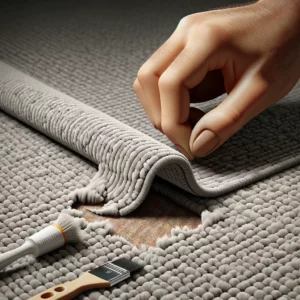Introduction to patching a hole in a damaged carpet
Dealing with a hole in your carpet can be a daunting task. Whether it’s from furniture mishaps, pet damage, or just wear and tear, a damaged carpet can significantly detract from the aesthetics of your room. However, patching a hole in a carpet is a feasible DIY task. In this comprehensive guide, we’ll explore detailed steps and tips to effectively repair your carpet, restoring its original look and extending its lifespan.
Please note — this is a very specialized process. It is recommended to seek a professional if you would like to patch a hole in your carpet.
Materials Needed for patching the hole

- Carpet remnants or a donor carpet
- Sharp scissors or a utility knife
- Carpet tape or adhesive
- A ruler or measuring tape
- A marker
- A heavy object (like a book)
Step-by-Step Guide to patching a hold in a damaged carpet
Step 1: Prepare the Area
Clean the area around the hole thoroughly. Remove any debris and ensure the carpet is dry. This will help the new patch adhere better.
Step 2: Measure and Cut the Donor Carpet
If you have remnants of your carpet, use those. Otherwise, cut a piece from a hidden area (like under the furniture or in a closet). Measure the hole and cut a piece from the donor carpet that is slightly larger than the hole.
Step 3: Mark and Cut the Damaged Area
Place the donor carpet piece over the damaged area and mark its dimensions. Ensure that the pattern or grain of the carpet matches. Using a ruler and a marker, draw an outline on the damaged carpet. Then, cut out the damaged section along the lines you drew.
Step 4: Apply the Adhesive
Put carpet tape or adhesive on the edges of the hole. Make sure it covers all sides but avoid putting too much as it may ooze out.
Step 5: Insert the Patch
Carefully place the patch into the hole. Ensure it fits snugly and aligns correctly with the carpet’s pattern. Press it down firmly.
Step 6: Secure the Patch
Place a heavy object like a book over the patched area. This will help in bonding the patch to the original carpet. Leave it for a few hours or as recommended by the adhesive instructions.
Step 7: Blend the Patch
Once the patch is set, gently brush the edges to blend it with the surrounding carpet. This helps in making the patch less noticeable.
Tips for a Successful Patch
Always cut the patch and the hole in a shape that is easy to match, like a square or rectangle.
Ensure the carpet grain or pattern matches to make the patch less visible.
Test the adhesive on a small, hidden part of the carpet to check for any discoloration.
If unsure, consult a professional.
Conclusion: how patch a hole in a damaged carpet
Patching a hole in a carpet may seem complex, but with the right tools and a bit of patience, it’s a task that can be accomplished effectively at home. Remember to take your time and pay attention to details like the direction of the carpet’s grain and the size of the patch. With these tips, your carpet can look as good as new in no time.
Disclaimer: This blog post is intended for informational purposes only. For more detailed or complex carpet repair, consulting a professional is recommended.



